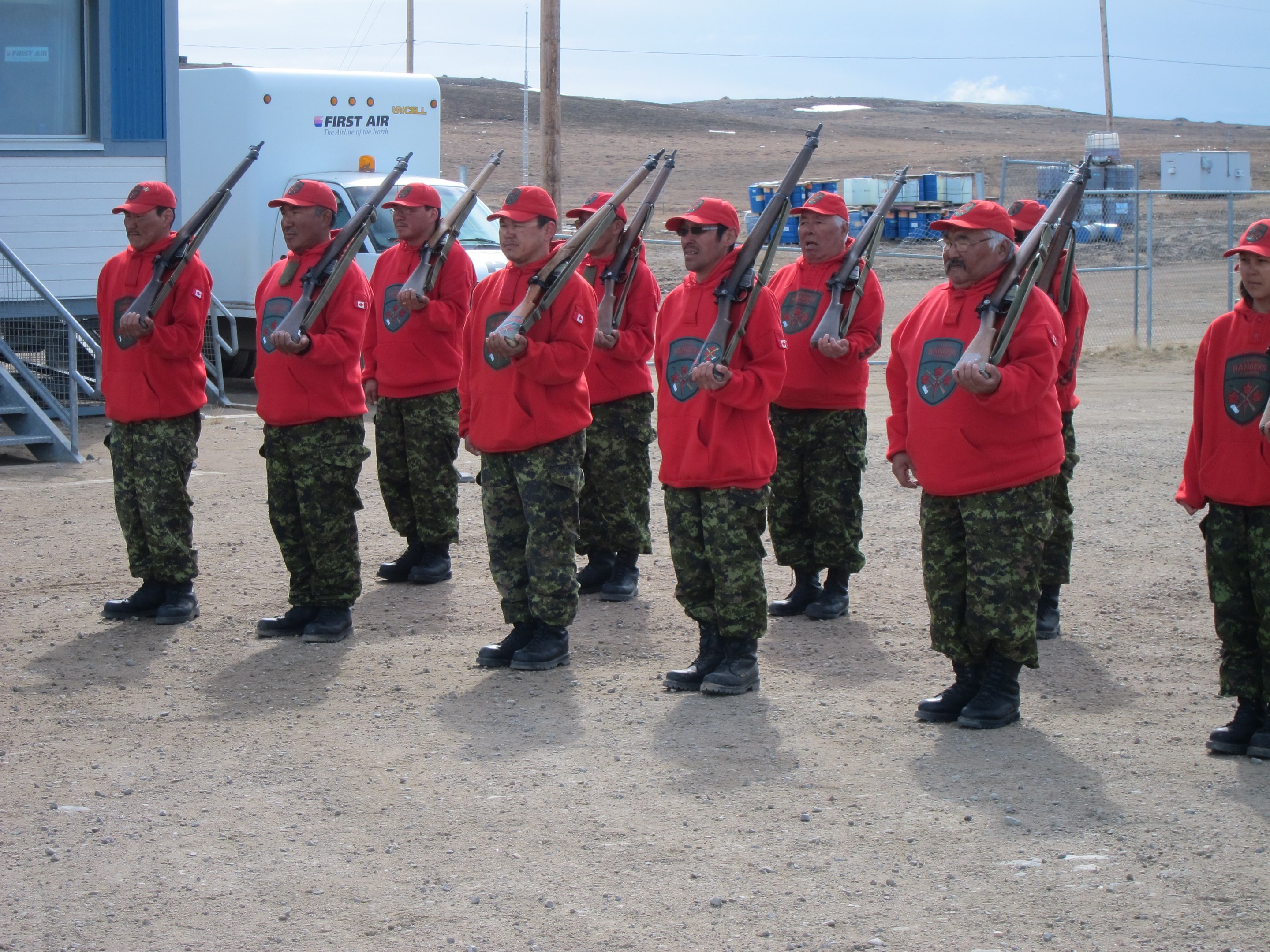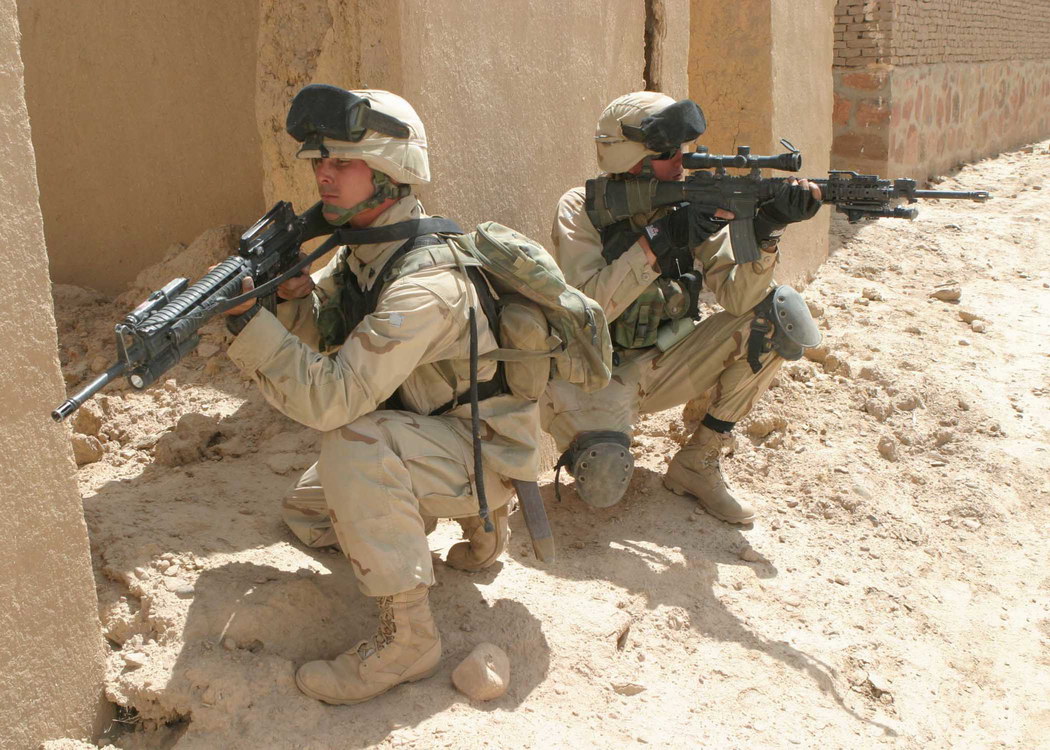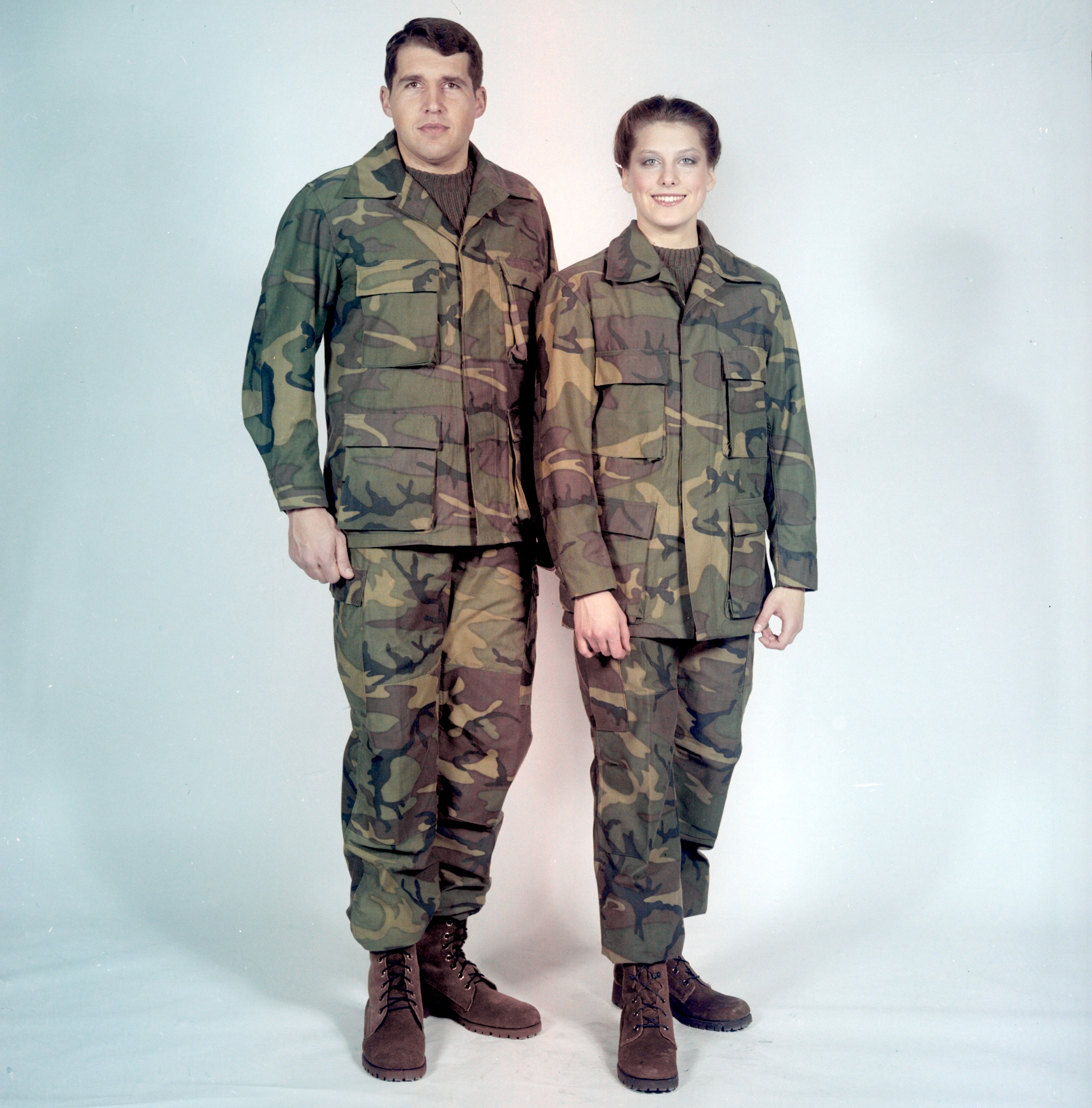|
CADPAT
Canadian Disruptive Pattern (CADPAT; french: links=no, dessin de camouflage canadien, DcamC) is the computer-generated digital camouflage pattern developed for use by the Canadian Armed Forces. Four operational variations of CADPAT have been used by the Canadian Armed Forces: a temperate woodland pattern, an arid regions pattern, a winter operations pattern, and a multi-terrain pattern. CADPAT was the first digital camouflage pattern to be used operationally, having been issued in 1997 with the Canadian Armed Forces. The pattern became fully standardized within the Canadian Armed Forces by 2002, having completely replaced the olive-drab operational uniforms formerly used by Regular Force units. The multi-terrain CADPAT variant began development in 2019, and is planned to replace the temperate woodland and arid regions CADPAT variations. History Canada's desire for a new soldier system dated back to November 1988 and closely followed efforts in many NATO countries. The first rese ... [...More Info...] [...Related Items...] OR: [Wikipedia] [Google] [Baidu] |
Uniforms Of The Canadian Armed Forces
The uniforms of the Canadian Armed Forces are the official dress worn by members of Canada's military while on duty. Prior to the unification of the Canadian Armed Forces, the uniforms of the Canadian Army, Royal Canadian Air Force (RCAF) and Royal Canadian Navy (RCN) were similar to their counterparts in the forces of the United Kingdom and other Commonwealth countries, save for national identifiers and some regimental accoutrements. With the unification of the Canadian Forces in 1968, all service branches began to wear Canadian Forces rifle green uniforms. ''Distinctive Environmental Uniforms'' (DEUs) for the various branches of the Canadian Forces was introduced in the late 1980s, and are generally similar to their pre-unification uniforms. Numbered Orders of Dress No. 1 (Ceremonial) Dress Full formal dress uniforms for ceremonial parades and other special occasions. * No. 1 (Accoutrements): Service Dress (see below) uniform with medals and ceremonial accoutrements (swo ... [...More Info...] [...Related Items...] OR: [Wikipedia] [Google] [Baidu] |
Digital Camouflage
Multi-scale camouflage is a type of military camouflage combining patterns at two or more scales, often (though not necessarily) with a digital camouflage pattern created with computer assistance. The function is to provide camouflage over a range of distances, or equivalently over a range of scales (scale-invariant camouflage), in the manner of fractals, so some approaches are called fractal camouflage. Not all multiscale patterns are composed of rectangular pixels, even if they were designed using a computer. Further, not all pixellated patterns work at different scales, so being pixellated or digital does not of itself guarantee improved performance. The first standardized pattern to be issued was the single-scale Italian ''telo mimetico''. The root of the modern multi-scale camouflage patterns can be traced back to 1930s experiments in Europe for the German and Soviet armies. This was followed by the Canadian development of the Canadian Disruptive Pattern (CADPAT), first i ... [...More Info...] [...Related Items...] OR: [Wikipedia] [Google] [Baidu] |
Military Camouflage
Military camouflage is the use of camouflage by an armed force to protect personnel and equipment from observation by enemy forces. In practice, this means applying colour and materials to military equipment of all kinds, including vehicles, ships, aircraft, gun positions and battledress, either to conceal it from observation ( crypsis), or to make it appear as something else (mimicry). The French slang word ''camouflage'' came into common English usage during World War I when the concept of visual deception developed into an essential part of modern military tactics. In that war, long-range artillery and observation from the air combined to expand the field of fire, and camouflage was widely used to decrease the danger of being targeted or to enable surprise. As such, military camouflage is a form of military deception. Camouflage was first practiced in simple form in the mid 18th century by rifle units. Their tasks required them to be inconspicuous, and they were issued gree ... [...More Info...] [...Related Items...] OR: [Wikipedia] [Google] [Baidu] |
List Of Military Clothing Camouflage Patterns
This is a list of military clothing camouflage patterns used for battledress. Military camouflage is the use of camouflage by a military force to protect personnel and equipment from observation by enemy forces. Textile patterns for uniforms have multiple functions, including camouflage, identifying friend from foe, and esprit de corps. The list is organized by pattern; only patterned textiles are shown. It includes current and past issue patterns, with dates; users may include armed force, armed, paramilitary force, paramilitary, police force, police, firefighting, search and rescue, counter-insurgency/counter-terrorism and other security forces and emergency services. __TOC__ Patterns See also * Military uniform * Snow camouflage#Military usage References External links CamopediaCamotestCamouflage Pattern Generator {{DEFAULTSORT:Camouflage Patterns Camouflage patterns, Military camouflage, Patterns Military lists Clothing-related lists, military ja:迷彩 ... [...More Info...] [...Related Items...] OR: [Wikipedia] [Google] [Baidu] |
MARPAT
MARPAT (short for Marine pattern) is a multi-scale camouflage pattern in use with the United States Marine Corps, designed in 2001 and introduced from late 2002 to early 2005 with the Marine Corps Combat Utility Uniform (MCCUU), which replaced the Battle Dress Uniform, Camouflage Utility Uniform. Its design and concept are based on the Canadian CADPAT pattern. The pattern is formed of small rectangular pixels of color. In theory, it is a far more effective camouflage than standard uniform patterns because it mimics the dappled textures and rough boundaries found in natural settings. It is also known as the "digital pattern" or "digi-cammies" because of its micropattern (pixels) rather than the old macropattern (big blobs). The United States government has patented MARPAT, including specifics of its manufacture. By regulation, the pattern and items incorporating it, such as the MCCUU and ILBE backpack, are to be supplied by authorized manufacturers only and are not for general co ... [...More Info...] [...Related Items...] OR: [Wikipedia] [Google] [Baidu] |
Canadian Forces Land Force Command
The Canadian Army (french: Armée canadienne) is the command (military formation), command responsible for the operational readiness of the conventional ground forces of the Canadian Armed Forces. It maintains regular forces units at bases across Canada, and is also responsible for the Army Reserve, the largest component of the Primary Reserve. The Army is headed by the concurrently held Commander of the Canadian Army and Chief of the Army Staff, who is subordinate to the Chief of the Defence Staff (Canada), Chief of the Defence Staff. The Army is also supported by 3,000 civilian employees from the civil service. Formed in 1855, as the Canadian Militia#Active militias, Active Militia, in response to the threat of the United States to the Province of Canada after the British Garrison left for the Crimean War. This Militia was later split into the Permanent Active Militia and the Non-Permanent Active Militia. Finally, in 1940, an Order in Council was issued to rename the active m ... [...More Info...] [...Related Items...] OR: [Wikipedia] [Google] [Baidu] |
Canadian Rangers
, colors =Red and green , march = , mascot = , battles = Second World WarCold War , anniversaries = , notable_commanders = , identification_symbol_2_label = , current_commander = Lieutenant-General Jean-Marc Lanthier, Commander of the Canadian Army , ceremonial_chief = , ceremonial_chief_label = , colonel_of_the_regiment = , website = , identification_symbol = , identification_symbol_label = NATO Map Symbol(2017) The Canadian Rangers (french: links=no, Rangers canadiens) are a 5,000-strong sub-component of the Canadian Armed Forces reserve that provide a limited military presence in Canada's sparsely settled northern, coastal, and isolated areas where it would not be economically or practically viable to have conventional Army units. Formally established on May 23, 1947, a primary role of this part-time force is to conduct surveillance or sovereignty patrols (SOV PATS) as required. Some Canadian Rangers also conduct inspections of the North Warning System (N ... [...More Info...] [...Related Items...] OR: [Wikipedia] [Google] [Baidu] |
Operation Enduring Freedom
Operation Enduring Freedom (OEF) was the official name used synonymously by the U.S. government for both the War in Afghanistan (2001–2014) and the larger-scale Global War on Terrorism. On 7 October 2001, in response to the September 11 attacks, President George W. Bush announced that airstrikes targeting Al-Qaeda and the Taliban had begun in Afghanistan. Operation Enduring Freedom primarily refers to the War in Afghanistan, but it was also affiliated with counterterrorism operations in other countries, such as OEF-Philippines and OEF-Trans Sahara. After 13 years, on 28 December 2014, President Barack Obama announced the end of Operation Enduring Freedom in Afghanistan. Subsequent operations in Afghanistan by the United States' military forces, both non-combat and combat, occurred under the name Operation Freedom's Sentinel. Subordinate operations Operation Enduring Freedom most commonly referred to the U.S.-led combat mission in Afghanistan. The codename was also used ... [...More Info...] [...Related Items...] OR: [Wikipedia] [Google] [Baidu] |
CFB Suffield
Canadian Forces Base Suffield (also CFB Suffield) is a Canadian Forces base, host to the largest military training area in Canada. It is located in southeastern Alberta, north-northwest of Suffield, northwest of the city of Medicine Hat and southeast of Calgary. It is accessible via Highway 884, a public road that bisects the main hub section of the base. The base has its own radio station, CKBF-FM, which airs programming for both the Canadian and British military personnel stationed at the base. The Crown Village of Ralston is located on base lands. History Chemical warfare training The lands comprising modern-day CFB Suffield were known as the "Suffield Block", resulting from the Dominion Land Survey, and comprised marginal agricultural land, given the perpetual semi-arid climate. Some settlement was attempted, but during the droughts of the 1920s most farms were abandoned, along with some horses, whose feral descendants formerly roamed the region. The total area measures a ... [...More Info...] [...Related Items...] OR: [Wikipedia] [Google] [Baidu] |
Desert Camouflage Uniform
The Desert Combat Uniform (DCU) is an arid-environment camouflage uniform that was used by the United States Armed Forces from the mid-1990s to the early 2010s. In terms of pattern and textile cut, it is identical to the U.S. military's Battle Dress Uniform (BDU) uniform, but features a three-color desert camouflage pattern of dark brown, pale olive green, and beige, as opposed to the four-color woodland pattern of the BDU. It replaced the previous Desert Battle Dress Uniform (DBDU) which featured a six-color "chocolate chip" pattern of beige, pale olive green, two tones of brown, and black and white rock spots. Although completely phased out of frontline use in the U.S. Armed Forces, some pieces and equipment printed in the DCU camouflage pattern are used in limited numbers such as MOPP suits and/or vests. History Developed in the late 1980s and first issued in very limited quantity in 1990 as experimental test patterns, the DCU and its camouflage scheme, officially known as th ... [...More Info...] [...Related Items...] OR: [Wikipedia] [Google] [Baidu] |
Battle Dress Uniform
The Battle Dress Uniform (BDU) is a camouflaged combat uniform that was used by the United States Armed Forces as their standard combat uniform from the early 1980s to the mid-2000s. Since then, it has been replaced or supplanted in every branch of the U.S. Armed Forces. BDU-style uniforms and derivatives still see widespread use in other countries (some of them being former U.S. surplus stocks transferred under U.S. security assistance programs), while others are still worn by some U.S. federal, state, and local law enforcement agents who may work in tactical situations, such as the DEA FAST and SWAT teams. The uniforms are also used by urban search and rescue groups such as FEMA USAR task force teams and firefighting agencies when conducting technical rescues or other special operations. As late as 2014, BDUs were worn by officers of the U.S. Public Health Service as the prescribed uniform for deployment, but have since been replaced by a variant of the U.S. Coast Guard ... [...More Info...] [...Related Items...] OR: [Wikipedia] [Google] [Baidu] |
United States Marine Corps
The United States Marine Corps (USMC), also referred to as the United States Marines, is the maritime land force service branch of the United States Armed Forces responsible for conducting expeditionary and amphibious operations through combined arms, implementing its own infantry, artillery, aerial, and special operations forces. The U.S. Marine Corps is one of the eight uniformed services of the United States. The Marine Corps has been part of the U.S. Department of the Navy since 30 June 1834 with its sister service, the United States Navy. The USMC operates installations on land and aboard sea-going amphibious warfare ships around the world. Additionally, several of the Marines' tactical aviation squadrons, primarily Marine Fighter Attack squadrons, are also embedded in Navy carrier air wings and operate from the aircraft carriers. The history of the Marine Corps began when two battalions of Continental Marines were formed on 10 November 1775 in Philadelphia as ... [...More Info...] [...Related Items...] OR: [Wikipedia] [Google] [Baidu] |


.jpg)
_(cropped).jpg)





